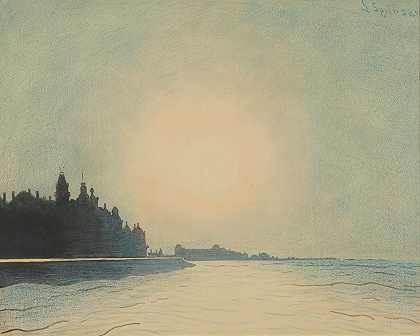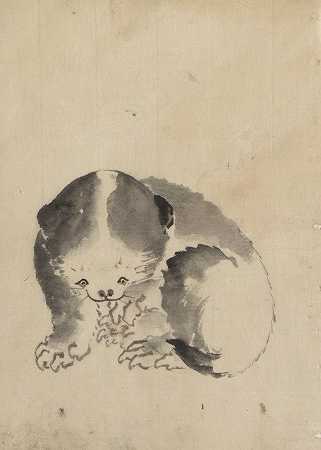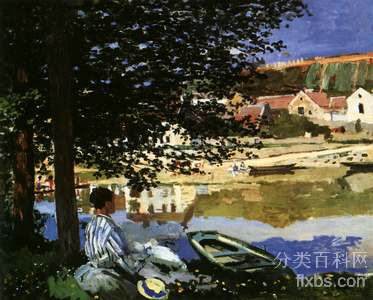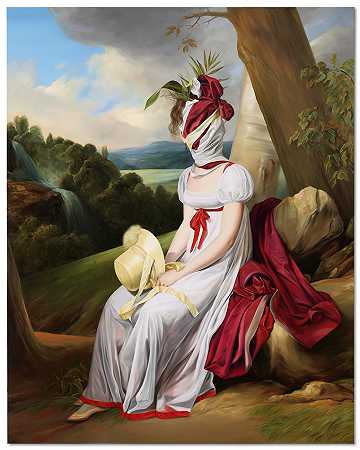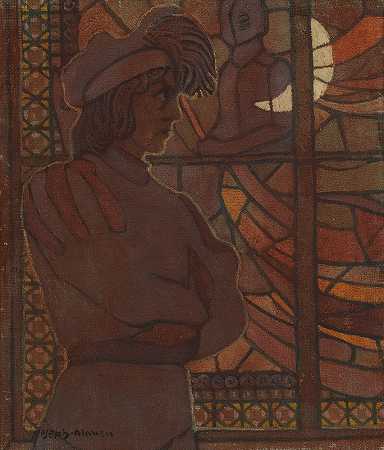日新录(8月31日 小雨)
Chapter 2: The Neoclassical Period
General Introduction
1. Duration:
Neoclassical period is the one in English literature between the return of Stuarts to the English throne in 1660 and the full assertion of Romanticism which came with the publication of Lyrical Ballads by Wordsworth and Coleridge in 1798. It’s in fact a turbulent period.

2. Political Background: The marking events:
The restoration of Charles II in 1660
The Glorious Revolution in 1689
Constant strife between the monarch and the parliament
Constant strife between big parties—the Tories and Whigs
Constant strife between ruling class and the laboring poor
Constant strife between religious sects, such as the Roman Catholicism and protestants (church of England)
The eighteenth century saw the fast development of England as a nation.
3. Social Background:
The eighteenth century saw the fast development of England as a nation. Abroad, a vast expansion of British colonies in North America, India, the West Indies, and a continuous increase of colonial wealth and trade provided England with a market for which the small-scale hand production methods of the home industry were hardly adequate, towards the middle of the eighteenth century; England had become the first powerful capitalist country in the world. The British bourgeois or middle class also grew rapidly. It was the major force of the Revolution and was mainly composed of city people. The British bourgeois or middle class believed in self-reliance, self- restraint and hard work.
The marking events:
Industrial revolution
A vast expansion of British colonies
A continuous increase of colonial wealth
4. Cultural Background:(Enlightenment)
The 18th-century England is known as the Age of Enlightenment or the Age of Reason.
Definition: The Enlightenment Movement was a progressive intellectual movement which flourished in France & swept through the whole Western Europe at the time. The movement was a furtherance of the Renaissance of the 15th & 16th centuries.
Function:
Its purpose was to enlighten the whole world with the light of modern philosophical & artistic ideas.
The enlighteners celebrated reason or rationality, equality & science.
They called for a reference to order, reason & rules & advocated universal education.
Famous among the great enlighteners in England were those great writers like John Dryden, Alexander pope & so on.
In the field of literature, the Enlightenment Movement brought about a revival of interest in the old classical works. This tendency is known as neoclassicism.
5. Viewpoints on literature:
According to the neoclassicists:
1All forms of literature were to be modeled after the classical works of the ancient Greek and Roman writers (Homer, Virgil, Horace, Ovid, etc.)
2They believed that the artistic ideals should be order, logic, restrained emotion and accuracy,
3Literature should be judged in terms of its service to humanity. This belief led them to seek proportion, unity, harmony and grace in literary expressions,
4In an effort to delight, instruct and correct human beings, primarily as social animals. Thus a polite urbane, witty, and intellectual art developed.
6. Fixed laws and rule on literature: Neoclassicists had some fixed laws and rules for almost every genre of literature.
1Prose should be precise, direct, smooth and flexible.
2Poetry should be lyrical, epical, didactic, satiric or dramatic, and each class should be guided by its own principles.
3Drama should be written in the Heroic Couplets.
7. The literature forms and streams during this period:
In the last few decades of the 18th century however, the neoclassical emphasis upon reason, intellect, wit and form was rebelled against or challenged by Sentimentalists, and was, in due time, gradually replaced by Romanticism.
The neoclassical period witnessed the flourishing of English poetry in the classical style from Restoration to about the second half of the century, climaxing with John Dryden, Alexander Pope and the last bearer of the school, Samuel Johnson.
The middle of 18th century was, however, predominated by a newly rising literary form —- the modern English novel, which, contrary to the traditional romance, gives a realistic presentation of life of common English people.
8. Gothic novels:
Gothic novels are mostly stories of mystery and horror which take place in some haunted or dilapidated Middle Class castles. They appeared from the middle part of the 18th century and were turned out profusely by male and female writers.
During this period, Richard Brinsley Sheridan was the leading figure among a host of playwrights.
And of the witty and satiric prose, those written by Jonathan Swift are worth studying, and his A Modest Proposal is generally regarded as the best model of the satire.
The typical authors during this period
I. Daniel Defoe
1. Daniel Defoe’s major works:
(Daniel Defoe’s) His works are the first literary works devoted to the study of problems of the lower-class people.
The Shortest Way with the Dissenters
《铲除非国教教徒的捷径》
The True-born Englishman
《纯正出身的英格兰人》
The Review 《书评》
Robinson Crusoe (most famous of his work, his masterpiece)
Captain Singleton《辛格尔顿船长》
Moll Flanders《摩根.佛兰德斯》
Colonel Jack《杰克上校》
Roxana《罗克珊娜》
A Journal of the Plague Year. 《大疫年日记》
2. Characteristics of his works:
Defoe was a very good story-teller. He had a gift for organizing minute details in such a vivid way that his stories could be both credible& fascinating.
His sentences are sometimes short, crisp & plain, & sometimes long & rambling, which leave on the reader on impression of casual narration.
His language is smooth, easy, colloquial & mostly vernacular. There is nothing artificial in his language: it is common English at its best.
II. Jonathan Swift
1. Introduction
1He was poor himself all his life; that is why he was very sympathetic toward the poor and political corruption in his writings.
2He had a deep hatred for all the rich oppressors and a deep sympathy for all the poor and oppressed.
3His understanding of human nature is profound.
4He is making the most devastating protest against the inhuman exploitation and oppression of the Irish people by the English ruling class.
5The apparent eagerness, sincerity and detachment of the author adds force to the bitter irony and biting sarcasm.
2. Masterpieces
A Tale of a Tub (satirist) 《木桶的故事》
The Battle of the Books 《书籍之战》
The Examiner 《主考》
Gulliver’s Travels (his greatest satiric work) 《格列佛游记》
A Modest Proposal (more powerful) 《一个温和的建议》
The Drapier’s Letters《德拉皮尔之信》
3. Writing styles:
1Swift is a master satirist. His satire is usually masked by an out word gravity &an apparent earnestness which renders his satire all the more powerful.
2Swift is one of the greatest masters of English prose. He is almost unsurpassed in the writing of simple, direct, precise prose. He defined a good style as “proper words in proper places.” Clear, simple, concrete diction, uncomplicated sentence structure, economy & conciseness of language mark all his writings-essays, poems & novels.
III. Henry Fielding
1. Introduction:
1He first tried his luck in play writing
2During 9 years, he produces 26 plays
3He was poor himself all his life; That is why he was very sympathetic toward the poor and political corruption in his writings; he adopted “the third-person narration”
2. Contributions:
1Father of the English Novel—because of his contribution and establishment of the form of the modern novel
2Of all the eighteenth-century novelists he was the first to set out, both in theory and practice:
First: give the modern novel both its structure and its style.
Second: adopted the “third-person narration” in which the author became the all-knowing God.
3. Main works: The earlier essays:
The True Patriot and the Liberty of Our Own Times
The Jacobite’s Journal
The Convent-garden Journal
Plays:
The Coffee-House Politician
The Tragedy of Tragedies
Pasquin
The Historical Register for the Year 1736
Novels:
The History of the Adventures of Joseph Andrews and of his friend Mr. Abraham Adams
The History of Jonathan Wild the Great
The History of Tom Jones, a Foundling –masterpiece on subject of human nature
The history of Amelia- a story of the unfortunate life of an idealized woman, a maudlin picture of the social life
4. Writing style:
The writing Tropism(取向)of his plays:
1witty comedies of manners or intrigues(诡计) in Restoration tradition
2farces(滑稽剧) or ballad operas with political implications(政治影射)
3burlesques( 闹 剧 ) and satires that bear heavily upon the status-quo( 现 状 ) of England
The writing Tropism of his novels: the ordinary and usually ridiculous (absurd) life of the common people, from the middle class to the underworld
The orientation(定位) of his novels:
Try to retain the grand epical form of the classical works but keep faithful to his realistic presentation of common life as it is
The object of his novels:
Not just to amuse but to instruct, and to present a faithful picture of life,” the just copy of human manners”
The writing characteristics:
1His language is easy, unlabored and familiar, but extremely vivid and vigorous.
2His sentences are always distinguished by logic and rhythm,
3His structure carefully planned towards and inevitable ending.
4His works are also noted for lively, dramatic dialogues and other theatrical devices such as suspense(悬念), coincidence(偶合) and unexpectedness(始料不及).
1. neoclassical [niːəʊ'klæ sɪk(ə)l] adj. 新古典主义的 E.g. The great political and social events in the English society of neoclassical period were the Restoration of King Charles II in 1660, the Great Plague of 1665 and the Great London Fire in 1666. 新古典主义时期的政治和社会事件包括 1660 年查理二世的 王朝复辟;1665 年的大瘟疫,以及 1666 年的伦敦大火。
2. literature ['lɪt(ə)rətʃə] n. 文学;文献;文艺;著作 E.g. literature review 文献回顾;文献综述;文献评论 literature and art 文艺;文学与艺术 english literature 英国文学;英语文化 E.g. Are you majoring in English Literature? 你主修的是英国文学吗?
3. literary ['lɪt(ə)(rə)rɪ] adj. 文学的;书面的;精通文学的 E.g. The novels of Daniel Defoe are the first literary works devoted to the study of problems of the lower–class people, such as Captain Singleton, Moll Flanders, Colonel Jack. 鲁滨逊的小说是首批描写底层人士的问题的文学作品,包括《辛格尔顿船长》《摩 尔·弗兰德斯 》《杰克上校》。
4.author ['ɔːθə] n. 作者;作家;创始人 E.g. Haruki Murakami is Japan’s best-selling author. 村上春树是日本的畅销书作家。 E.g. Henry Fielding adopted the third-person narration to relate a story in a novel, in which the author becomes the “all- knowing God”.亨利·菲尔丁采用“第三人称叙述”, 来讲述小说中的故事,其中作者成为“全知的上帝”。
5. plot [plɒt] n. 情节;图;阴谋 vt. 密谋;绘图;划分;标绘 vi. 密谋;策划;绘制 E.g. Do you know the main plot of Robinson Crusoe? 你知道《鲁宾逊漂流记》的主要情节吗?
6. prose [prəʊz] n. 散文;单调 adj. 散文的;平凡的;乏味的 E.g. As one of the greatest masters of English prose, Jonathan Swift defined a good style as “proper words in proper places.”作为英语散文的大师之一,乔纳森·斯威夫特认 为好的语言风格是“在恰当的地方用恰当的词。”
7. satire ['sætaɪə] n. 讽刺;讽刺文学,讽刺作品 E.g. As a whole, Gulliver’s Travels is one of the most effective and devastating criticisms and satires of all aspects in the then English and European life socially, politically,religiously,philosophically,scientifically,andmorally. 总的来说,《格列夫游记》是最有效和最具破坏性的批评,也是对当时英国和欧洲生活各个方面社会,政治, 宗教,哲学,科学和道德上的讽刺。
8. satiric [sə'tɪrɪk] adj. 讽刺的;挖苦的 E.g. Jonathan Swift’s greatest satiric work is A Modest Proposal, not only of the period but also in the whole English literary history. 《一个温和的建议》是乔纳森•斯威夫特最好的讽刺作品。不仅是这一时期讽刺的最佳例子,而且也是整个英国文学史上的典范。
9. structure ['strʌktʃə] n. 结构;构造;建筑物 E.g. Of all the eighteenth – century novelists, Henry Fielding was the first to set out, both in theory and practice, to write specifically a “comic epic in prose”, the first to give the modern novel its structure and style. 在十八世纪所有小说家中,亨利.菲尔丁第 一个在理论与实践上创造了“散文体喜剧史诗”,并第一个为现代小说确立了结构和风格。
10. enlightenment [ɪn'laɪt(ə)nm(ə)nt] n. 启迪;启蒙运动;教化 E.g. The 18th-century England is known as the Age of Enlightenment or the Age of Reason.18 世纪的英国被称为启蒙时代或者理性时代。
11. political [pə'lɪtɪk(ə)l] adj. 政治的;党派的 E.g. As a whole, Gulliver's Travels is one of the most effective and devastating criticisms and satires of all aspects in the then English and European life socially, politically, religiously, philosophically, scientifically, and morally. 总的来说,《格列夫游记》是最有效和最具破坏性的批评,也是对当时英国和欧洲生活各个方面社会,政治, 宗教,哲学,科学和道德上的讽刺。
12. select [sɪ'lekt] vt. 挑选;选拔 adj. 精选的;挑选出来的;极好的 E.g. We have over 30 beautiful designs to select from.我们有 30 多种美丽的图案可供 选择。 E.g. selected reading 名篇选读
13. social ['səʊʃ(ə)l] adj. 社会的,社交的;群居的 E.g. Social Background 社会背景 Social achievement 社会成就 Social life 社会生活 E.g. Henry Fielding’s novel The History of Amelia is a masterpiece on the subject of the story of the unfortunate life of an idealized woman, a maudlin(伤感的) picture of the social life at the time.《阿米亚的故事》是以一个理想化的女人的不幸生活为题材的故 事,反映了当时社会生活的伤感图景。
14. absurd [əb'sɜːd] adj. 荒谬的;可笑的 n. 荒诞;荒诞作品 E.g. What an absurd idea! 多么荒唐的念头! E.g. Henry Fielding tends to write the ordinary and usually ridiculous (absurd) life of the common people, from the middle class to the underworld.亨利菲尔丁倾向于写从中产阶级到下层社会的普通人的平凡和荒诞的生活。
15. artistic [ɑː'tɪstɪk] adj. 艺术的;风雅的;有美感的 E.g. artistic achievement 艺术成就 artistic value 艺术价值 ; 艺术性
16. background ['bæ kgraʊnd] n. 背景;隐蔽的位置 E.g. Social Background 社会背景 Political Background 政治背景 cultural background 文化背景 educational background 学历;教育背景
17. bourgeois ['bʊəʒwɑː] n. 资本家 adj. 资产阶级的;中产阶级的 E.g. The British bourgeois or middle class believed in self-reliance, self- restraint and hard work. 十八世纪晚期到十九世纪早期,英国的工业革命正在进行中,而工业革命的主角——英 国资产阶级自信,自强,自制的特点为其积累财富奠定了基础,也为英国文学发展的现 实主义奠定了基础。
18. devastating ['devəsteitiŋ] adj. 毁灭性的;全然的 v. 摧毁(devastate 的 ing 形 式);毁坏 E.g. Jonathan Swift’ s A Modest Proposal makes the most devastating protest(抗议) against the inhuman exploitation and oppression of the Irish people by the English ruling class. 乔纳森·斯威夫特《一个温和的建议》(以温和冷静的语言)强烈谴责了英国政府对爱尔兰的压迫以及不人道的剥削(文字“不温不火,绵里藏针”,颇能体现斯威夫特的讽刺 风格)。
19. masterpiece ['mɑːstəpiːs] n. 杰作;绝无仅有的人 E.g. Daniel Defoe’s Robinson Crusoe is universally considered as his masterpiece. Friday is a character in the novel Robinson Crusoe. 《鲁滨逊漂流记》被公认为是丹尼尔笛福的杰作。Friday 是《鲁宾逊漂流记》中的人物。
20. narration [nə'reɪʃ(ə)n] n. 叙述,讲述;故事 E.g. Henry Fielding adopted the third-person narration to relate a story in a novel, in which the author becomes the “all- knowing God”.亨利·菲尔丁采用“第三人称叙述”, 来讲述小说中的故事,其中作者成为“全知的上帝”。
21. restoration [restə'reɪʃ(ə)n] n. 恢复;复位;王政复辟;归还 E.g. The great political and social events in the English society of neoclassical period were the Restoration of King Charles II in 1660, the Great Plague of 1665 and the Great London Fire in 1666. 新古典主义时期的政治和社会事件包括 1660 年查理二世的,王朝复辟;1665 年的大瘟疫,以及 1666 年的伦敦大火。
22. revolution [revə'luːʃ(ə)n] n. 革命;旋转;运行;循环 E.g. Industrial revolution 工业革命 The Glorious Revolution in 1689 1689 年光荣革命
23. witty ['wɪtɪ] adj. 诙谐的;富于机智的 E.g. His plays were very good, very witty. 他的那些剧作非常好,非常诙谐。
24. philosophical [fɪlə'sɒfɪk(ə)l] adj. 哲学的;冷静的 E.g. As a whole, Gulliver's Travels is one of the most effective and devastating criticisms and satires of all aspects in the then English and European life socially, politically, religiously, philosophically, scientifically, and morally. 总的来说,《格列 夫游记》是最有效和最具破坏性的批评,也是对当时英国和欧洲生活各个方面社会,政 治,宗教,哲学,科学和道德上的讽刺。
25. sympathy ['sɪmpəθɪ] n. 同情;慰问;赞同 E.g. Among the novelists of mid-eighteenth century, Daniel Defoe gave his praise to unfortunate poor in most of his works. 在十八世纪中期的小说家中,笛福在大部分作 品中都表达了对勤劳的人和坚实的中产阶级的赞美以及对被压迫的和不幸的人们的同情。
5、 简述新古典主义、浪漫主义、现实主义美术的基本特征?
新古典主义(英语︰Neoclassicism),兴起于18世纪的罗马,并迅速在欧美地区扩展的艺术运动。新古典主义,一方面起于对巴洛克(Baroque)和洛可可(Rococo)艺术的反动,另一方面则是希望以重振古希腊、古罗马的艺术为信念。新古典主义的艺术家刻意从风格与题材模仿古代艺术,并且知晓所模仿的内容为何。
选择严峻的重大题材(古代历史和现实的重大事件), 在艺术形式上,强调理性而非感性的表现;在构图上强调完整性;在造型上重视素 描和轮廓,注重雕塑般的人物形象,而对色彩不够重视。法国新古典主义美术从维安、达维德到 安格尔, 取得了最优秀的成就,并达到高峰。
浪漫主义是文艺的基本创作方法之一,与现实主义同为文学艺术上的两大主要思潮。作为创作方法,浪漫主义在反映客观现实上侧重从主观内心世界出发,抒发对理想世界的热烈追求,常用热情奔放的语言、瑰丽的想象和夸张的手法来塑造形象。浪漫主义的创作倾向由来已久,早在人类的文学艺术处于口头创作时期,一些作品就不同程度地带有浪漫主义的因素和特色。但这时的浪漫主义既未形成思潮,更不是自觉为人们掌握的创作方法。浪漫主义作为一种主要文艺思潮,从18世纪后半叶至19世纪上半叶盛行于欧洲并表现于文化和艺术的各个部门。
现实主义是国际关系中的主流理论,它也是一个多义且有争议的概念。虽然现实主义的批评者和支持者经常将其视为一个统一的思想整体,但实际上,现实主义并不是一个单一或统一的理论。正如杰克·唐纳利所指出,现实主义不仅不能提供一种一般理论,而且它基本上也是前后矛盾的,现实主义者对同一事件的解释经常不一致。“现实主义变成了建立在共同预设理论假定之上、有点松散联系的前后不一致的理论模式。”因此,了解现实主义,除了解现实主义的世界观和基本假定这些共同点之外,了解现实主义者之间的不同也是十分重要的。本文拟以经典现实主义和新现实主义为例,通过探讨现实主义理论的多样性,进而来揭示现实主义在国际秩序模式上的异同之处。

